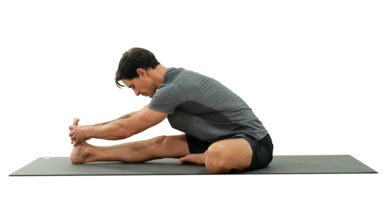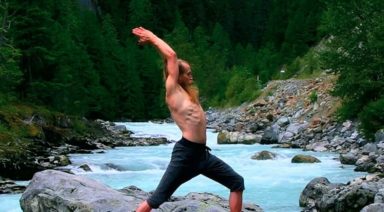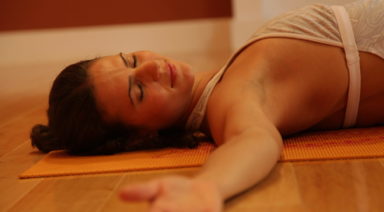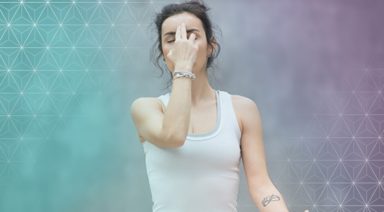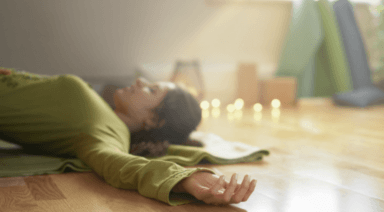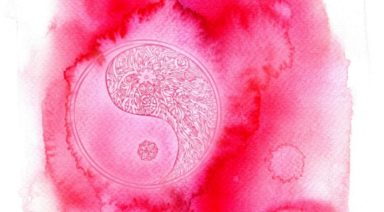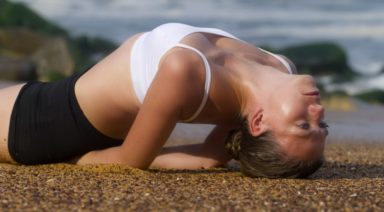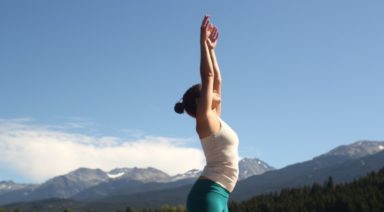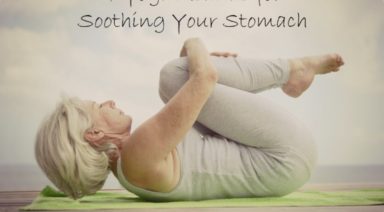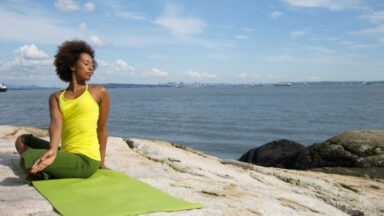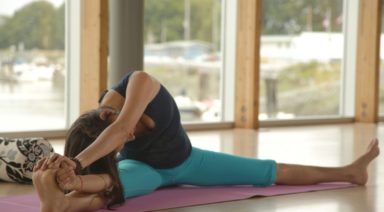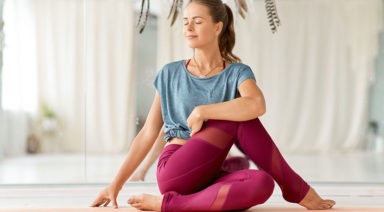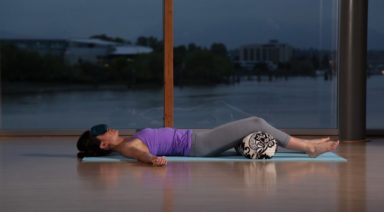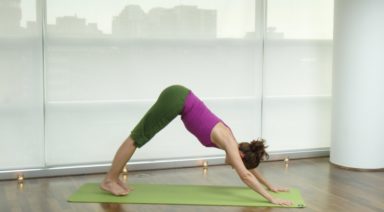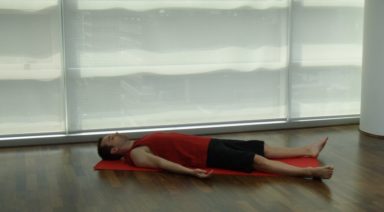Parivrtta Utkatasana: Revolved Chair Pose
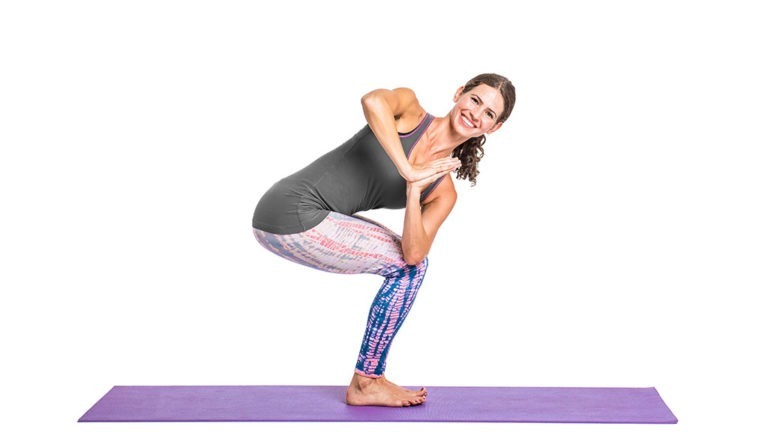
ADJUSTMENTS | BENEFITS | SEQUENCING | SANSKRIT | STEPS
Parivrtta utkatasana (par-ee-vrit-tah OOT-kah-TAHS-anna) lives up to the Sanskrit translation of power and ferocity. A great way to strengthen and lengthen the leg muscles, this challenging posture also lengthens and improves mobility in the spine. Practicing parivrtta utkatasana will give a feeling of groundedness in the lower half of the body and open spaciousness in the upper body.
Philosophy + Origin
Parivrtta utkatasana is an opportunity to practice the concept of “rooting to rise.” In order to deepen the posture, you must find strength in the legs and lightness in the spine and upper body. While it’s easy to only focus on deepening the twist, the best results come from first setting up your foundation. This philosophy of building a strong foundation through rooting and grounding is helpful in life. While your goals and aspirations, even your daily to-dos, can constantly demand your attention, get strong through your roots before you try to spread your wings.
ADJUSTMENTS/MODIFICATIONS:
- Use a folded blanket or rolled yoga mat beneath your heels to keep your feet firmly planted when practicing this posture.
- Keep your knees stay together to help stabilize your pelvis and protect your lower back.
- Place a block between your inner thighs. Squeeze the block as you twist to help keep your knees aligned.
STEP-BY-STEP:
- Begin in chair pose with knees together and weight mostly in your heels.
- Bring your hands together into a prayer position at the center of your chest.
- Inhale to lengthen your spine. Exhale to hinge forward then twist to your right, hooking your left elbow outside your right thigh.
- Press your palms together to create more space between your collarbones.
- Keep your knees together. Lower your hips an extra inch.
- Hold for 3-5 breaths before releasing to a forward fold. Return to chair and repeat on the other side.
PREPARATORY POSES:
- Chair pose | Utkatasana
- Mountain pose | Tadasana
- Crescent lunge | Anjenayasana
SEQUENTIAL POSES:
- One-Footed Pose Dedicated to the Sage Koundinya I | Eka pada Koundinyasana I
- Revolved crow pose | Parsva bakasana
- Half lord of the fishes | Ardha matsyendrasana
COUNTER POSES:
- Standing forward fold | Uttanasana
- Gorilla pose | Padahastasana
- Runners lunge | Utthan pristhana
SANSKRIT:
- Parivrtta = revolved
- Utkata = powerful, fierce
- Asana = pose
PHYSICAL BENEFITS:
- Strengthens hip flexor muscles, front of thighs, adductors, and gluteus muscles.
- Lengthens side bodies.
- Opens chest, shoulders, and upper back.
ENERGETIC BENEFITS:
- Grounding.
- Ignites and stimulates agni (digestive fire) in your belly.
Legal Disclaimer Before participating in any exercise program or using any fitness products or services that may be described and/or made accessible in or through the Gaia Website and/or the Services, you should consult with a physician or other healthcare provider. Read more about Gaia’s Terms Of Use.
Ustrasana: Camel Pose
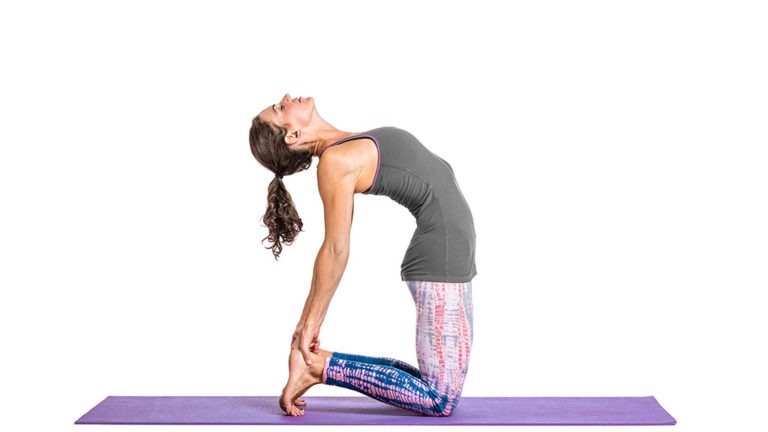
ADJUSTMENTS | BENEFITS | MANTRA | MUDRA | PREP POSES | SANSKRIT | STEPS
Ustrasana (oosh-TRAHS-anna), offers a long list of benefits for both the physical and subtle bodies. Thanks to its many different variations and modifications, there are plenty of ways for individuals of all levels to appreciate the chest-opening and chakra-opening effects of camel pose.
Philosophy + Origin
Camel pose is named because the shape resembles the hump on a camel’s back, however there are other ways to consider the name when approaching the posture. Camels are known for their slow, steady, almost methodical way of moving. Rather than trying to race into the posture, moving slowly and methodically will help you find its benefits safely. Camels use their humps as food reserves, like well-packed bags ready to be used when needed. This type of physical preparation, a part of the camel’s natural adaptation for survival, is essential for this pose as well. Take your time to gather and practice the skills and knowledge necessary to take a back-bending journey to ensure that you come in and out of the posture with ease and poise.




